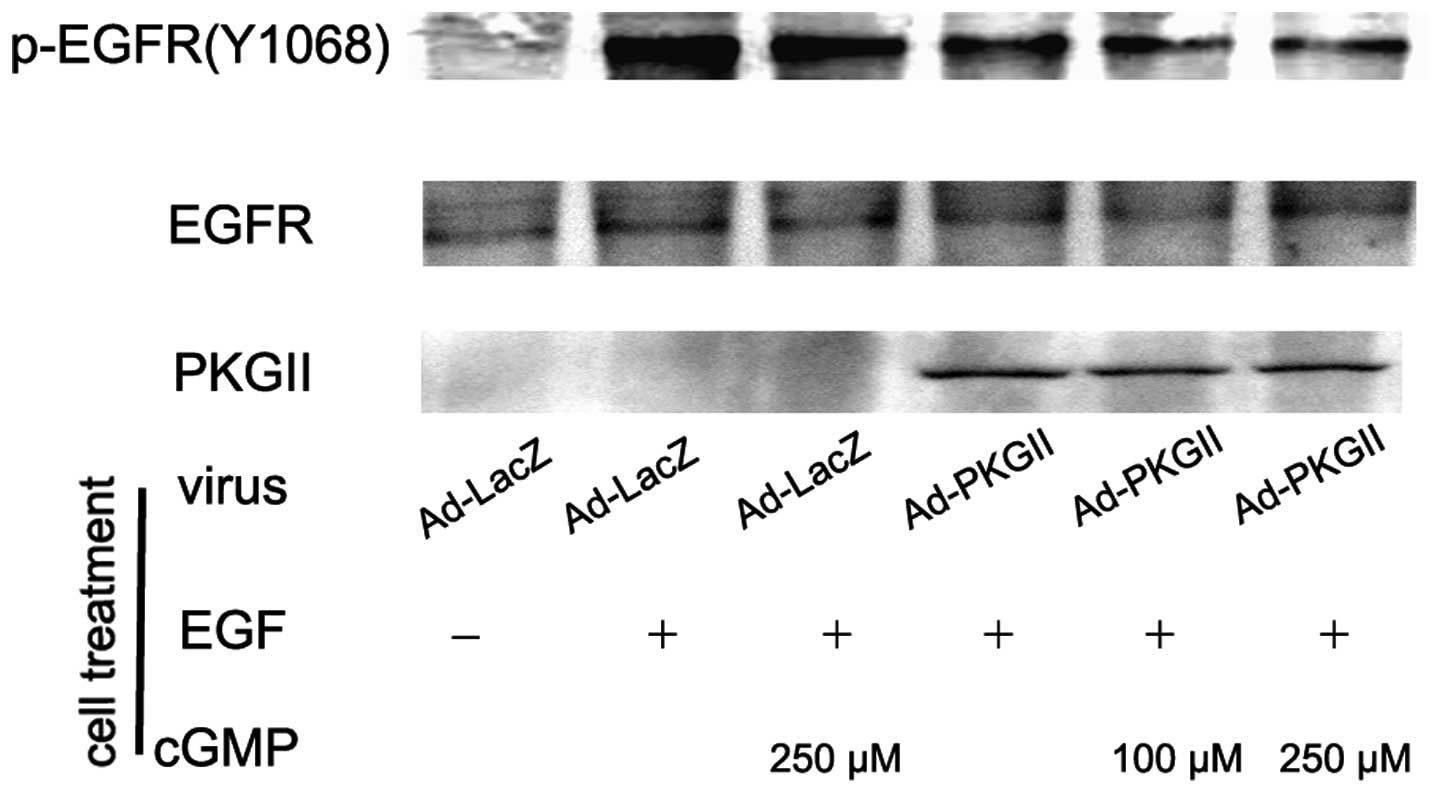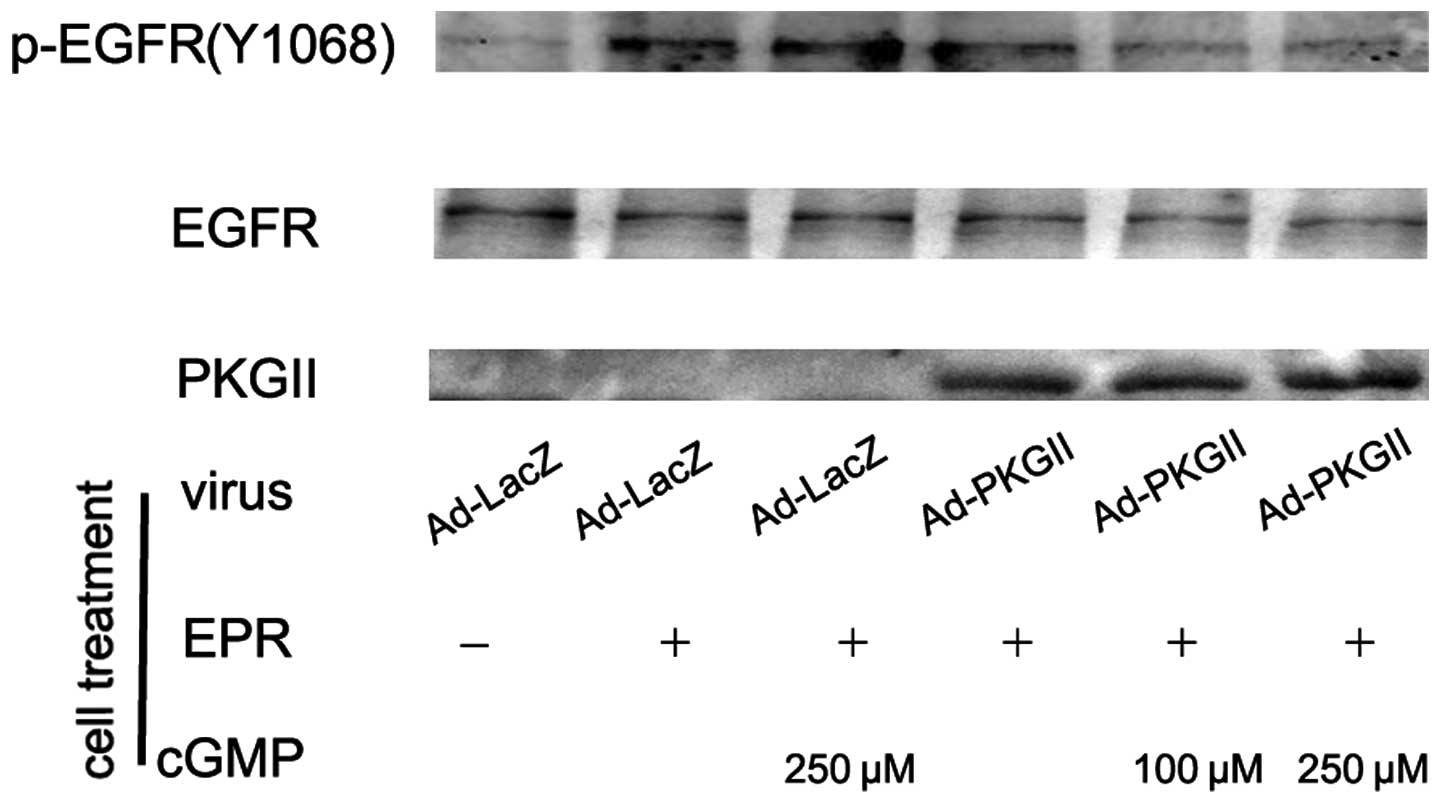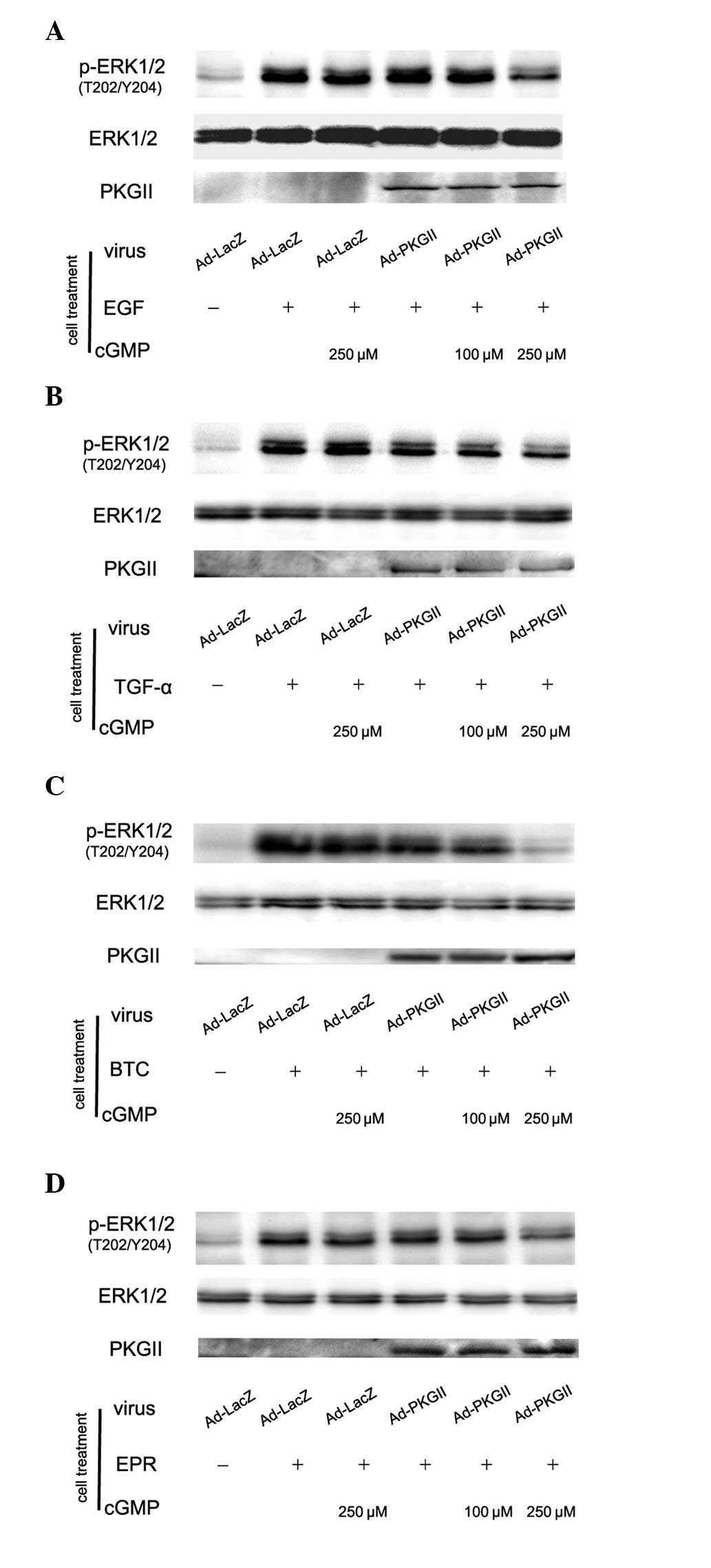|
1
|
Shah MA and Schwartz GK: Treatment of
metastatic esophagus and gastric cancer. Semin Oncol. 31:574–587.
2004. View Article : Google Scholar : PubMed/NCBI
|
|
2
|
Becker JC, Muller-Tidow C, Serve H, et al:
Role of receptor tyrosine kinases in gastric cancer: new targets
for a selective therapy. World J Gastroenterol. 12:3297–3305.
2006.PubMed/NCBI
|
|
3
|
Arnold D, Peinert S, Voigt W, et al:
Epidermal growth factor receptor tyrosine kinase inhibitors:
present and future role in gastrointestinal cancer treatment: a
review. Oncologist. 11:602–611. 2006. View Article : Google Scholar : PubMed/NCBI
|
|
4
|
Johnston JB, Navaratnam S, Pitz MW, et al:
Targeting the EGFR pathway for cancer therapy. Curr Med Chem.
13:3483–3492. 2006. View Article : Google Scholar : PubMed/NCBI
|
|
5
|
Astsaturov I, Cohen RB and Harari PM:
EGFR-targeting monoclonal antibodies in head and neck cancer. Curr
Cancer Drug Targets. 6:691–710. 2006. View Article : Google Scholar : PubMed/NCBI
|
|
6
|
Oda K, Matsuoka Y, Funahashi A and Kitano
H: A comprehensive pathway map of epidermal growth factor receptor
signaling. Mol Syst Biol. 1:2005.0010. 2005.PubMed/NCBI
|
|
7
|
Yarden Y and Shilo BZ: SnapShot: EGFR
signaling pathway. Cell. 131:10182007. View Article : Google Scholar : PubMed/NCBI
|
|
8
|
Arteaga CL: Overview of epidermal growth
factor receptor biology and its role as therapeutic taget in human
neoplasia. Semin Oncol. 29:3–9. 2002. View Article : Google Scholar : PubMed/NCBI
|
|
9
|
Krozely P: Epidermal growth factor
receptor tyrosine kinase inhibitors: evolving role in the treatment
of solid tumors. Clin J Oncol Nurs. 8:163–168. 2004. View Article : Google Scholar : PubMed/NCBI
|
|
10
|
Cook AL and Haynes JM: Protein kinase G
II-mediated proliferative effects in human cultured prostatic
stromal cells. Cell Signal. 16:253–261. 2004. View Article : Google Scholar : PubMed/NCBI
|
|
11
|
Swartling FJ, Ferletta M, Kastemar M, et
al: Cyclic GMP-dependent protein kinase II inhibits cell
proliferation, Sox9 expression and Akt phosphorylation in human
glioma cell lines. Oncogene. 28:3121–3131. 2009. View Article : Google Scholar : PubMed/NCBI
|
|
12
|
Fallahian F, Karami-Tehrani F, Salami S,
et al: Cyclic GMP induced apoptosis via protein kinase G in
oestrogen receptor-positive and -negative breast cancer cell lines.
FEBS J. 278:3360–3369. 2011. View Article : Google Scholar : PubMed/NCBI
|
|
13
|
Swartling FJ, Ferletta M, Kastemar M, et
al: Cyclic GMP-dependent protein kinase II inhibits cell
proliferation, Sox9 expression and Akt phosphorylation in human
glioma cell lines. Oncogene. 28:3121–3131. 2009. View Article : Google Scholar : PubMed/NCBI
|
|
14
|
Wang R, Kwon IK, Thangaraju M, et al: Type
2 cGMP-dependent protein kinase regulates proliferation and
differentiation in the colonic mucosa. Am J Physiol Gastrointest
Liver Physiol. 303:G209–G219. 2012. View Article : Google Scholar : PubMed/NCBI
|
|
15
|
Chen YC, Ren F, Sang JR, et al: Type II
cGMP-dependent protein kinase inhibits proliferation of the gastric
cancer cell line BGC-823. Mol Med Rep. 3:361–366. 2010.PubMed/NCBI
|
|
16
|
Jiang L, Lan T, Chen Y, et al: PKG II
inhibits EGF/EGFR-induced migration of gastric cancer cells. PLoS
One. 8:e616742013. View Article : Google Scholar : PubMed/NCBI
|
|
17
|
Wu Y, Chen Y, Qu R, et al: Type II
cGMP-dependent protein kinase inhibits EGF-triggered signal
transduction of the MAPK/ERK-mediated pathway in gastric cancer
cells. Oncol Rep. 27:553–558. 2012.PubMed/NCBI
|
|
18
|
Lan T, Chen Y, Sang J, et al: Type II
cGMP-dependent protein kinase inhibits EGF-induced MAPK/JNK signal
transduction in breast cancer cells. Oncol Rep. 27:2039–2044.
2012.PubMed/NCBI
|
|
19
|
Harris RC, Chung E and Coffey RJ: EGF
receptor ligands. Exp Cell Res. 284:2–13. 2003. View Article : Google Scholar
|
|
20
|
Prigent SA and Lemoine NR: The type I
(EGFR-related) family of growth factor receptors and their ligands.
Prog Growth Factor Res. 4:1–24. 1992. View Article : Google Scholar : PubMed/NCBI
|
|
21
|
Barnard JA, Beauchamp RD, Russell WE, et
al: Epidermal growth factor-related peptides and their relevance to
gastrointestinal pathophysiology. Gastroenterology. 108:564–580.
1995. View Article : Google Scholar : PubMed/NCBI
|
|
22
|
D’Agnano I, D’Angelo C, Savarese A, et al:
DNA ploidy, proliferative index, and epidermal growth factor
receptor: expression and prognosis in patients with gastric
cancers. Lab Invest. 72:432–438. 1995.PubMed/NCBI
|
|
23
|
Wells A: EGF receptor. Int J Biochem Cell
Biol. 31:637–643. 1999. View Article : Google Scholar
|
|
24
|
Takemura S, Yashiro M, Sunami T, et al:
Novel models for human scirrhous gastric carcinoma in vivo. Cancer
Sci. 95:893–900. 2004. View Article : Google Scholar : PubMed/NCBI
|
|
25
|
Wang C, Lv X, Jiang C, et al: Transforming
growth factor alpha (TGFα) regulates granulosa cell tumor (GCT)
cell proliferation and migration through activation of multiple
pathways. PLoS One. 7:e482992012.
|
|
26
|
Dias A, Garcia C, Majewski M, et al:
Gastric juice prostaglandins and peptide growth factors as
potential markers of chronic atrophic gastritis, intestinal
metaplasia and gastric cancer: their potential clinical
implications based on this pilot study. Dig Dis Sci. 56:3220–3225.
2011. View Article : Google Scholar
|
|
27
|
Yoshida K, Kyo E, Tsujino T, et al:
Expression of epidermal growth factor, transforming growth
factor-alpha and their receptor genes in human gastric carcinomas;
implication for autocrine growth. Jpn J Cancer Res. 81:43–51. 1990.
View Article : Google Scholar
|
|
28
|
Sasada R, Ono Y, Taniyama Y, et al:
Cloning and expression of cDNA encoding human betacellulin, a new
member of the EGF family. Biochem Biophys Res Commun.
190:1173–1179. 1993. View Article : Google Scholar : PubMed/NCBI
|
|
29
|
Dunbar AJ and Goddard C:
Structure-function and biological role of betacellulin. Int J
Biochem Cell Biol. 32:805–815. 2000. View Article : Google Scholar : PubMed/NCBI
|
|
30
|
Shing Y, Christofori G, Hanahan D, et al:
Betacellulin: a mitogen from pancreatic beta cell tumors. Science.
259:1604–1607. 1993. View Article : Google Scholar : PubMed/NCBI
|
|
31
|
Seno M, Tada H, Kosaka M, et al: Human
betacellulin, a member of the EGF family dominantly expressed in
pancreas and small intestine, is fully active in a monomeric form.
Growth Factors. 13:181–191. 1996. View Article : Google Scholar : PubMed/NCBI
|
|
32
|
Toyoda H, Komurasaki T, Uchida D, et al:
Epiregulin. A novel epidermal growth factor with mitogenic activity
for rat primary hepatocytes. J Biol Chem. 270:7495–7500.
1995.PubMed/NCBI
|
|
33
|
Toyoda H, Komurasaki T, Uchida D, et al:
Distribution of mRNA for human epiregulin, a differentially
expressed member of the epidermal growth factor family. Biochem J.
326:69–75. 1997.PubMed/NCBI
|
|
34
|
Das SK, Das N, Wang J, et al: Expression
of betacellulin and epiregulin genes in the mouse uterus temporally
by the blastocyst solely at the site of its apposition is
coincident with the “window” of implantation. Dev Biol.
190:178–190. 1997.PubMed/NCBI
|
|
35
|
Komurasaki T, Toyoda H, Uchida D, et al:
Mechanism of growth promoting activity of epiregulin in primary
cultures of rat hepatocytes. Growth Factors. 20:61–69. 2002.
View Article : Google Scholar : PubMed/NCBI
|
|
36
|
Shirakata Y, Komurasaki T, Toyoda H, et
al: Epiregulin, a novel member of the epidermal growth factor
family, is an autocrine growth factor in normal human
keratinocytes. J Biol Chem. 275:5748–5753. 2000. View Article : Google Scholar : PubMed/NCBI
|
|
37
|
Rangaswami H, Marathe N, Zhuang S, et al:
Type II cGMP-dependent protein kinase mediates osteoblast
mechanotransduction. J Biol Chem. 284:14796–14808. 2009. View Article : Google Scholar : PubMed/NCBI
|
|
38
|
Nie HG, Chen L, Han DY, et al: Regulation
of epithelial sodium channels by cGMP/PKGII. J Physiol.
587:2663–2676. 2009. View Article : Google Scholar : PubMed/NCBI
|












